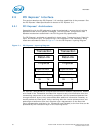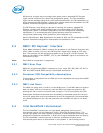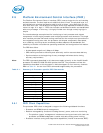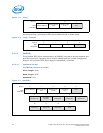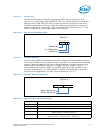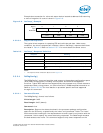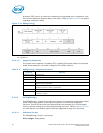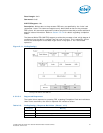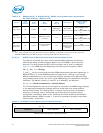
34 Intel® Xeon® Processor E5-1600/E5-2600/E5-4600 Product Families
Datasheet Volume One
For the processor PECI client the Revision Number will return ‘0011 0100b’.
2.5.2.3 GetTemp()
The GetTemp() command is used to retrieve the maximum die temperature from a
target PECI address. The temperature is used by the external thermal management
system to regulate the temperature on the die. The data is returned as a negative
value representing the number of degrees centigrade below the maximum processor
junction temperature (T
jmax
). The maximum PECI temperature value of zero
corresponds to the processor T
jmax
. This also represents the default temperature at
which the processor Thermal Control Circuit activates. The actual value that the
thermal management system uses as a control set point (T
CONTROL
) is also defined as a
negative number below T
jmax
. T
CONTROL
may be extracted from the processor by
issuing a PECI RdPkgConfig() command as described in Section 2.5.2.4 or using a
RDMSR instruction. T
CONTROL
application to fan speed control management is defined in
the Intel® Xeon® Processor E5-1600/E5-2600/E5-4600 Product Families Thermal/
Mechanical Design Guide.
Please refer to Section 2.5.7 for details regarding PECI temperature data formatting.
2.5.2.3.1 Command Format
The GetTemp() format is as follows:
Write Length: 0x01
Read Length: 0x02
Command: 0x01
Description: Returns the highest die temperature for addressed processor PECI client.
5 Ping(), GetDIB(), GetTemp(), WrPkgConfig(), RdPkgConfig(), RdIAMSR(),
RdPCIConfigLocal(), WrPCIConfigLocal(), RdPCIConfig(), WrPCIConfig()
6 Ping(), GetDIB(), GetTemp(), WrPkgConfig(), RdPkgConfig(), RdIAMSR(),
RdPCIConfigLocal(), WrPCIConfigLocal(), RdPCIConfig(), WrPCIConfig(), WrIAMSR()
Table 2-2. Minor Revision Number Meaning
Minor Revision Supported Command Suite
Figure 2-8. GetTemp()
Byte #
Byte
Definition
0
Client Address
1
Write Length
0x01
2
Read Length
0x02
4
FCS
5
Temp[7:0]
6
Temp[15:8]
7
FCS
3
Cmd Code
0x01



